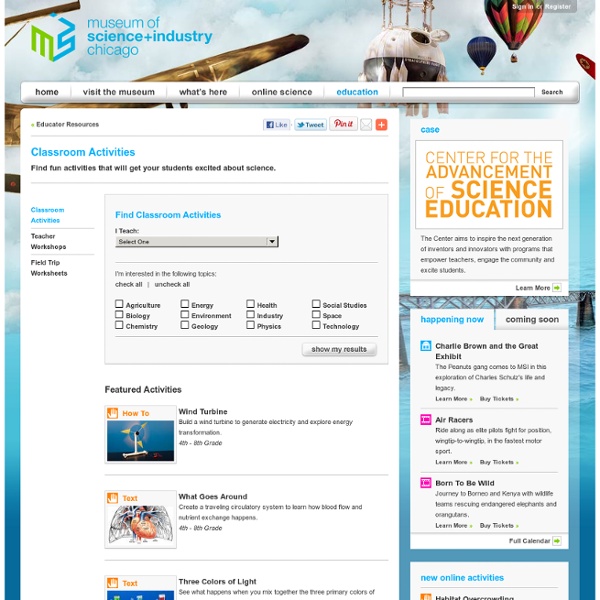



Exploratorium: the museum of science, art and human perception Edheads - Activate Your Mind! The Physics Classroom Lawrence Hall of Science - 24/7 Science How fast does the wind blow? What makes things sticky? Where do insects live and plants grow? So many questions—and so many ways to find answers! Bridge Builders How Fast Is the Wind Gooo! Filling Without Spilling Parachute Drop Crystals Bird Beaks Sticky Situations Oil Spill How Old is Your Penny? Measure Yourself Where Do Plants Grow? Bug Hunt! Afterschool KidzScience AfterSchool KidzScience™ kits are designed specifically for children in grades 3 - 5 in out-of-school settings. Check Out Science Check Out Science makes doing science with your family easy, no scientific expertise necessary. Explore Your World You don't have to trek through a rainforest, blast off for space, or dive to the deep sea to explore your world. Roadside Heritage Roadside Heritage is an informal science educational project with its origins in the stunning landscape of the Eastern Sierra along the 395 scenic byway. Save Sam! Green Milk Save Ratty Virus Worker Nano Puzzle How Small is Small What is an SEM? Mr.
Rader's GEOGRAPHY 4 KIDS.COM The Nine Planets Solar System Tour Baby Beluga, Swim So Wild And Sing For Me hide captionNOC, seen here in an image from an archival video, was recorded in the 1980s making vocalizations that imitated human speech. The findings weren't published until this week. Current Biology NOC, seen here in an image from an archival video, was recorded in the 1980s making vocalizations that imitated human speech. Whales are among the great communicators of the animal world. And one whale in particular has apparently done something that's never been documented before: He imitated human speech. Sounds From The Whale Named NOC Normal White Whale Sounds The beluga, or white whale, is smallish as whales go and very cute, if you're into marine mammals. These sounds are for things like echolocation, like bats use, or for basic communication, as in, "Hello, honey, I'm home." But a white whale at San Diego's National Marine Mammal Foundation did something very different. A curious Ridgway started recording NOC. When NOC was mimicking humans, Ridgway looked inside the whale's nose.
Earth - Your life on earth Explore BBC Earth's unique interactive, personalised just to you. Find out how, since the date of your birth, your life has progressed; including how many times your heart has beaten, and how far you have travelled through space. Investigate how the world around you has changed since you've been alive; from the amount the sea has risen, and the tectonic plates have moved, to the number of earthquakes and volcanoes that have erupted. Grasp the impact we've had on the planet in your lifetime; from how much fuel and food we've used to the species we've discovered and endangered. And see how the BBC was there with you, capturing some of the most amazing wonders of the natural world. Explore, enjoy, and share with your friends either the whole page, or your favourite insights. This is your story, the story of your life on earth. BBC Earth's Your life on earth is based on the following sources. Lead photo credit: John Kellerman / Alamy.
Must Have STEM Tools by edshelf: Reviews & recommendations of tools for education STEM is not only a national priority, but an essential part of a modern workforce. To help your students prepare for the 21st century, teaching an integrated science, technology, engineering, and math curriculum is critical. Fortunately, there are numerous websites and mobile apps that can help. South Carolina math and engineering teacher Chris Beyerle curates the following collection of must-have STEM tools. He includes stalwarts (such as Google Earth and Bill Nye the Science Guy), newer mobile games (such as Vernier Video Physics and Monster Physics), and critical references (such as Pocket Body and goREACT). There is a treasure trove of tools here. Which STEM tools do you use in your classroom? 43 Must Have STEM Tools From edshelf Image attribution flickr user rdecom
Molecular Workbench Three Views of MW Senior Scientist and Molecular Workbench Developer Charles Xie, Researcher and Manager Amy Pallant, and Technology and Curriculum Developer Dan Damelin describe the history of Molecular Workbench and our vision for the future. Watch the Video undefinedundefinedundefined Selected Curriculum Modules Transistor Semiconductor Plasma Molecular Rover Chemical Bonding Chemical Resp. Diffusion Heat & Temperature Electrostatics Phase Change DNA to Protein Mission: Immunity Lipids & Carbs Tree of Life Proteins & DNA Harvest Light Quantum Mechanics Crystallography More Modules » Launches MW Create Your Own Simulations MW is not just a collection of simulations—do not be deceived by first glance. Learn More in MW's Online Manual » Launches MW Create Your Own Curriculum Modules A simulation without instructional support is difficult for students to use. Learn More in MW's Online Manual » Launches MW Fun Stuff Electrostatic Maze 3D Maze Roving Nanogear Block Feeder Probability Machine Dainty Walker Water Wheels